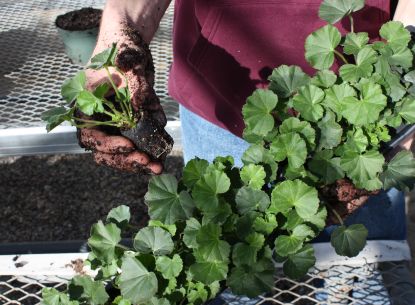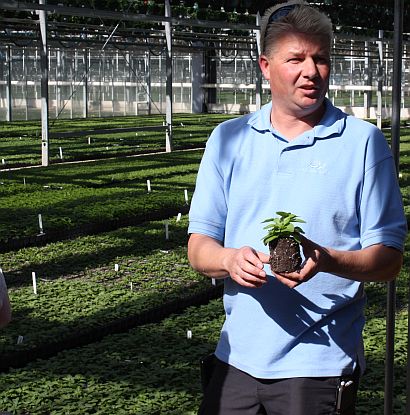I enjoyed Jeff’s post on the RootTrapper and thought I’d share another interesting and [relatively] new development in the world of greenhouse growing containers.
Take a tube full of growing media, wrap a paper sleeve around it, and voila – the Ellepot!

It’s bottomless, root permeable, and degradable. Each Ellepot sits in its own cell in a re-usable tray. The great aeration and drainage makes for a happy, healthy root system. Another plus is that after transplanting, there are no pots or packs to throw away
I’d say the bulk of Elle Pots are utilized at the propagation end of things – starting seeds and rooting vegetative cuttings – either for greenhouses to “grow on” themselves or as plug/liner products sold to finishing growers (see student Paul Hutcheson holding a geranium liner above).
Ella and Ojvind Ellegard of Denmark developed the system in the early 1990’s. Popular with growers in Europe, they’ve made their way to North America. Growers can buy in Ellepots by the pallet from various sources, or can invest in the equipment to make them

Wrap it up, I’ll take it…an Ellepot machine at Battlefield Farms, Rapidan, Virginia.
Sizes run from 15 mm (288 cells per 20” x 10” tray) up to 120 mm – equivalent to a 4” pot, perfect for bedding plants. Landscapers love them if they can find them – less waste from installation sites.

Petunia in an Ellepot. That’s Marc Verdel, head grower at Battlefield Farms.
As far as retail goes, I’m not sure if any market research has been done as to consumer preferences for this “pot-less” system. It’s a slight challenge for a shopper to pick one of this and two of that and transport them – you need some kind of carry tray. Anyone out there experienced with Ellepots (grower or gardener)?
Several of our plug vendors use them and appear to like them. I’ve honestly not seen much difference between a well grown conventional plug and a well grown Elle, but if there weren’t advantages, I don’t think it would have caught on quite as quickly as it has.
I think the Elle system could work especially well for landscapers doing big annual installs. They don’t even want tags let alone pots since it’s just extra clean up for them at the end of the job. We haven’t figured out how to make it work yet, but I’m chewing on it.
Thanks for the background!
We trialed Ellepots for retail sales with some of our natives and fast succulents last year, but the
retail customers just didn’t get it…. So we are using plantable coir pots for things that can dry out a bit and using rice-hull compostable pots for our 4″ and liter natives and perennials. We have also started growing most of our gallon production in rice-hull and it has been a hit with our customers. We have been running a nice increase in that size ever since we rolled them out!
I may try Ellepots again for our Carex pansa and other CA native meadow grasses for turf replacement jumbo plug tray sales, but it will have to wait until our stock of coir cell trays are all used up.
Hap, thanks for the info. Can you give me more information as to customer response? I’ve heard some other folks are doing well with the coir pots, just curious as why they didn’t go for the Ellepots. Are the increased sales of 1 gal rice hull pots covering the additional cost of the pot sufficiently?
Paul, I’ve heard the advantage is more at the propagator end of things – faster rooting (more O2? not sure why).
Holly,
The average customer didn’t like the Ellepot “feel” when picking up and putting it in to the shuttle tray, they were just too “gooey”. They would go for pre-packed assorted six-packs, but didn’t want to handle them to pick their own assortment. Even putting out wax paper deli squares and food prep gloves didn’t help the ick factor with some of the customers. And since we offer assorted succulent and native starter plants, that the more you buy, the lower the price is, it needs to be self service. The coir fiber pots may be a bit “hairy” by the time they sell, but is still easier to handle in a retail setting. Also with coir and rice-hull we can use our own soil blends, rather than having to pick a prefilled Ellepot with limited soil choices, (we are just not big enough to buy a filling machine). The rice-hull pots are actually not that bad price point (by the pallet load) and the price difference was easy to just work in to our pricing. Besides being a Berkeley and Bay Area nursery it helps us make our “Brand” stand out with our customers. It is too bad the 5 gallon size rice-hull pots are way too expensive or I would use them as well.
We are near an ellepot supplier, Blackmoor of Belleville, MI, who gave us sample boxes of different sizes of the pots in their custom plastic trays for Master Gardeners to try. Seed germination and rooting of cuttings in them is far superior to peat or coir pellets but once the pots, in plastic trays, dry out before use they are difficult to re-wet, like bulk peat. I wish they were as available at retail as the pellets.
We are a retail grower, producing about a million units of 4″ annuals per year. We made the switch this year and purchased a machine to make the 70mm ellepots. We had been using the 35mm ellepot for most of our vegetative propagation, with outstanding results. The cuttings rooted faster, and performed better when shifted to larger containers. I knew my landscapers would embrace the switch, but I didn’t know how it would be received by the general public. Spring is almost over, and I have had a total of three complaints. The overwhelming majority of feedback has been positive. I am now thinking about getting rid of 5″ pots in favor of the 90mm ellepot.
We have a number of customers that have great success in the retail market with Jumbo Ellepots!
We realize that the Ellepot is not a “good” looking as ordinary & bio plastic pots, but the customers we know have success has turned that to their advantage by selling 6,9, 18 counts.
Feel free to email us at info@ellepot-usa.com with questions or concerns at any time or look us up at http://www.ellepot-usa.com.
In regards to the rewet issue! Blackmore more has a great growing mix, however the amount of wetting agent in the mix is very low therefore you will have a very hard time to rewet the mix if you let it dry out! Talk to Meadow Ridge, Zylstra or Walters Gardens in Michigan they produce their own Ø70mm for retail!
However, it is important to remember the Ellepot will dry out faster than pots! That is part of the reason why people like them, but it is important to make sure that you do not transplant a dry Ellepot … that will give you issues!
We have a number of retailers doing a very good job with Ellepots. Good signage and a trained staff goes a long way with the educating the consumer. Really all that has to be done is tell the consumer that this is an environmentally friendly solution. They embrace it every time!
Price also matters!
The fact that Ellepot paper for a 4″ is about half the price of an ordinary plastic pot and many times cheaper than other bio products is also a factor in some cases!